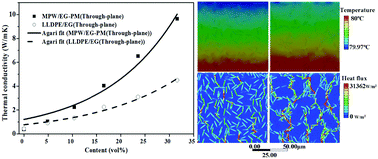High-performance thermal and electrical conductive composites from multilayer plastic packaging waste and expanded graphite†
Abstract
Plastic film packaging waste is an important environmental concern worldwide, and finding effective ways to reuse multilayer plastic packaging waste (MPW) presents major challenges. However, current recycling technologies for multilayer plastic packaging often lead to low-quality products. Herein, we reported a facile route to produce value-added MPW composites with high isotropic thermal conductivity and efficient electromagnetic interference shielding effectiveness (EMI SE) for the first time. Using solid-state shear milling (S3M) technology, flaky MPW powder is successfully fabricated, which is followed by a powder mixing (PM) and compression molding process to produce a continuous expanded graphite (EG) network. As a result, the MPW/EG-PM composites (31.6 vol%) exhibit a superb through-plane thermal conductivity of 9.7 W m−1 K−1 and an anisotropy of 1.1. The Agari model fitting coefficient revealed the effective fabrication of a continuous 3D network and the finite element simulation visually confirmed the excellent heat-transfer capabilities of the filler network in the MPW/EG-PM composites. Moreover, such a 3D network also led a low electrical conductivity percolation threshold of 2.6 vol%, a high EMI SE of 44.8 dB and satisfactory mechanical strength. Such materials not only remove environmental pollution but also have potential applications in the cooling electronics and electromagnetic interference shielding areas.



 Please wait while we load your content...
Please wait while we load your content...